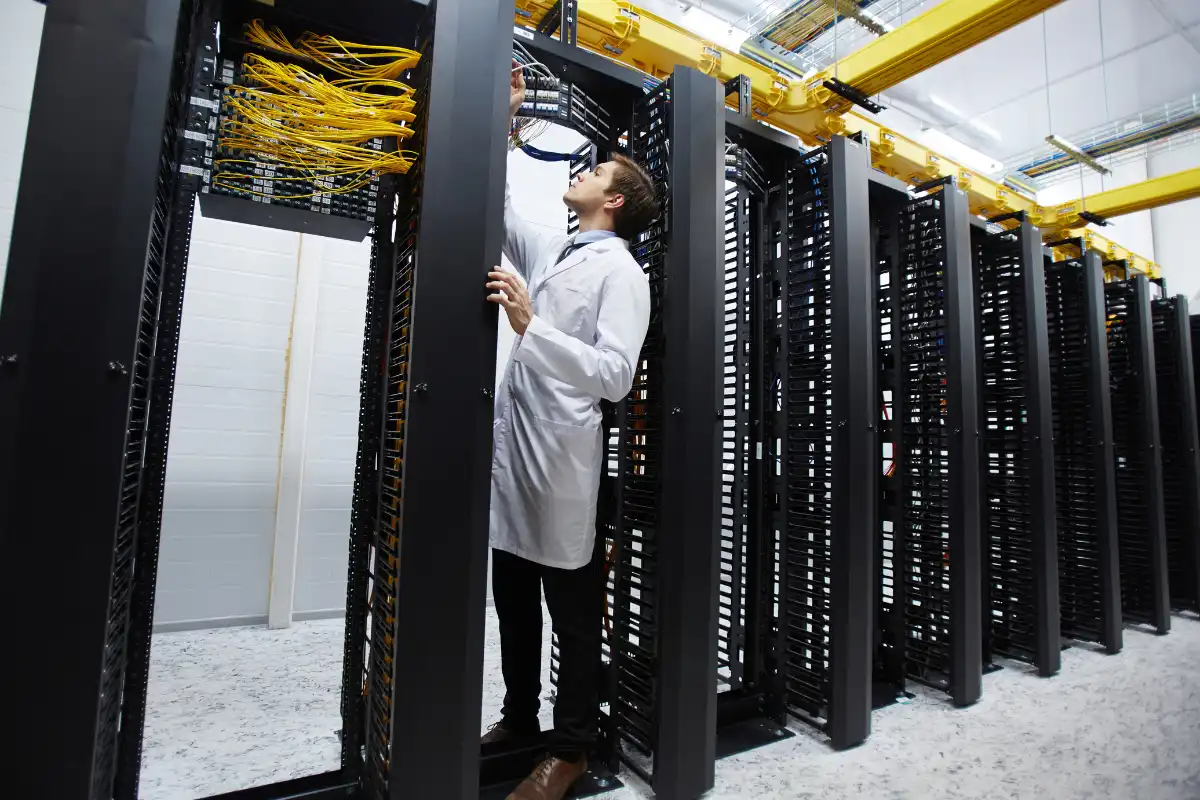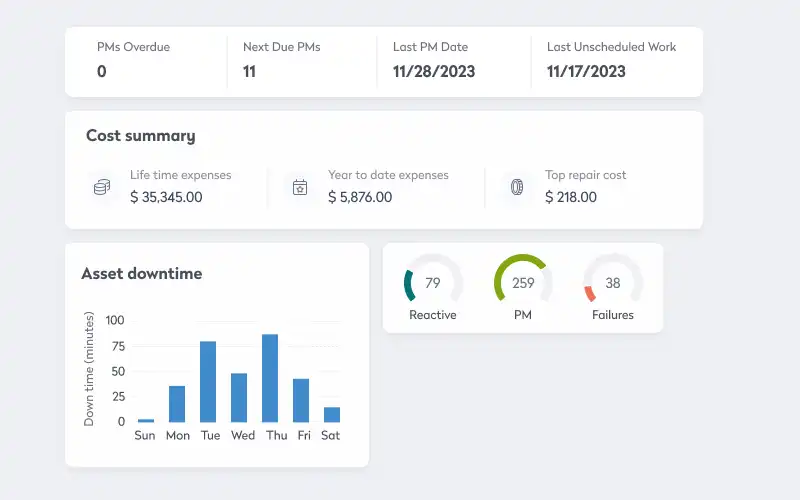
To understand the critical role data centers play at enterprise-size companies, you need only look at the cost of downtime. For large organizations, it can be $9,000 per minute on average, while in higher-risk, highly regulated industries like finance, it’s possible to exceed $5 million an hour, according to recent research.
Companies can reduce their risk through a multifaceted proactive approach that includes implementing cybersecurity tools and investing in backup and disaster recovery systems. Facility managers also have an important role to play through ongoing space, infrastructure, and access management.
The challenges of space and infrastructure planning for data centers
Facility managers face many challenges in maintaining a cost-effective and high-performing data center, particularly in the areas of floor space optimization and vertical integration. Inefficient space use can lead to higher operational costs and reduced performance. Strategic placement of server racks, cooling systems, and other equipment is essential to minimize wasted space and improve accessibility. Facility managers must carefully plan the layout to ensure that critical equipment is easily accessible for maintenance and monitoring, while also optimizing the flow of personnel and visitors. A properly planned space reduces the need for additional physical space and enhances operational efficiency, leading to lower costs and better performance.
Utilizing vertical space through multi-tiered rack systems can also be a challenge. While the approach allows for a higher density of servers and storage units within a given area, which is particularly beneficial for data centers with limited expansion options, implementing vertical integration requires careful consideration of cooling efficiency. Facility managers must balance the need for increased equipment density with the potential for overheating and increased energy costs.
There are also many critical elements in infrastructure planning, including:
- Power management: Ensuring a stable and efficient power supply is critical for data center reliability. Facility managers must navigate the complexity of uninterruptible power supplies, power distribution units, and energy-efficient systems, requiring constant monitoring and maintenance to prevent power-related issues and downtime.
- Cooling systems: Implementing and maintaining advanced cooling solutions like liquid cooling and hot aisle/cold aisle configurations is essential but challenging due to the high initial costs and the need for precise temperature control to reduce energy expenses and equipment failure.
- Environmental controls: Monitoring and controlling factors like temperature, humidity, and air quality are vital for IT equipment. Advanced monitoring systems are necessary to track these conditions in real-time and address issues promptly, making it a continuous challenge to maintain optimal conditions and comply with environmental standards to avoid regulatory penalties and ensure safe operations.
By addressing these issues, you can significantly improve performance, reduce costs, and ensure compliance with regulatory standards and industry best practices.
How a modern facility management platform increases reliability and efficiency at data centers
A modern facility management platform plays an important role in achieving operational goals by providing advanced tools and insights. From preventive and predictive maintenance to real-time communication, a facility team can leverage the software to better manage data centers.
Implementing preventive and predictive maintenance
A modern facility management solution can help significantly improve the operational efficiency of a data center through predictive maintenance analytics. For example, you can leverage maintenance and repairs data to predict when an uninterruptible power supply might need servicing based, preventing costly outages and ensuring that the data center operates at peak performance. A proactive approach not only minimizes maintenance costs but also enhances the reliability of the data center.

Enhancing communication between teams
Effective communication between different teams, such as IT, facilities, and security, is crucial for the smooth operation of a data center. Modern facility management solutions facilitate better communication by providing real-time data and alerts, which help in coordinating activities and responding quickly to any issues. For example, if a cooling system fails, the software can immediately notify the facilities team, IT team, and security personnel, ensuring a coordinated and rapid response. This real-time communication improves overall operational efficiency, reduces the time it takes to resolve issues, and helps maintain the integrity and security of the data center.
Streamlining resource allocation and utilization
Optimizing the allocation and utilization of resources is another key benefit of a modern facility management platform. By providing detailed insights into space usage, power consumption, and equipment performance, the platform helps data center managers make informed decisions. This can lead to more efficient use of physical space, reduced energy costs, and better management of hardware assets. For instance, identifying underutilized server racks or redundant cooling units can help in reallocating resources to areas where they are needed most, enhancing overall efficiency and reducing operational expenses.
Monitoring assets in real-time with IoT sensors
Internet of Things (IoT) sensors can continuously monitor various aspects of the data center environment, providing real-time data that is crucial for maintaining optimal conditions and preventing issues before they become critical.
IoT sensors can track temperature, humidity, and air quality in real-time, for example, which is essential for keeping servers and other equipment running efficiently. If the temperature in a server room starts to rise, the system can automatically adjust the cooling systems or alert the facilities team to act, preventing overheating and potential equipment failure.
The facility team can also use sensors to monitor power consumption and distribution, helping to identify inefficiencies and potential power surges. The team can use the data to optimize energy usage, reduce costs, and ensure that power is distributed evenly across the data center. For example, if a particular server rack is consuming more power than expected, the platform can suggest load balancing or power management strategies to improve efficiency.
The platform can automatically generate alerts and notifications based on sensor data, ensuring that the right teams are informed of any issues. For example, if a sensor detects a sudden drop in humidity, the facilities team can be notified immediately to address the problem, preventing damage to sensitive equipment.
How visitor management systems at data centers support security and boost efficiency
By automating and streamlining the visitor check-in and check-out process, VMS ensures that only authorized individuals can enter the facility, while also offering valuable insights the facility team can leverage to optimize various aspects of data center operations.
Compliance and auditing
Compliance and auditing are critical for large enterprises, and VMS plays a significant role in this area. These systems can generate detailed logs and reports of all visitor activities, which are essential for compliance and auditing purposes. By maintaining a clear and auditable record of who has entered the data center and what they did, companies can ensure that they meet industry standards and regulatory requirements. This data can be used to demonstrate adherence to security policies and to identify any areas where improvements are needed.
Access control
By automating the check-in and check-out process, VMS ensures that only authorized visitors and employees can access specific areas of the data center.
Real-time access control offers several advantages, including:
- Enhanced security: VMS can instantly verify the identity and authorization status of every individual attempting to enter the data center. This helps in preventing unauthorized access and reducing the risk of security breaches. For example, if a visitor’s credentials are not recognized or if they are flagged for any reason, the system can immediately deny entry and alert security personnel.
- Centralized management: VMS allows for centralized management of access control, making it easier to monitor and manage visitor access across multiple locations. This is especially useful for large enterprises with distributed data centers, as it ensures consistent security protocols and reduces the administrative burden on local staff.
- Immediate alerts and notifications: The system can send real-time alerts and notifications to relevant teams when a visitor enters or exits the facility. This ensures that all stakeholders are aware of who is on-site and can respond quickly to any potential issues. For example, if a visitor is in a restricted area, the security team can be notified immediately to take appropriate action.
- Dynamic access control: VMS can dynamically adjust access permissions based on real-time conditions. For example, if a server room is undergoing maintenance, the system can temporarily restrict access to that area, ensuring that only authorized personnel can enter.
By implementing real-time access control through a VMS, data centers can significantly enhance their security measures, reduce operational risks, and improve the overall efficiency of their access management processes.
Visitor analytics
The facility team can leverage data in the VMS to generate valuable visitor analytics, which can be used to optimize various aspects of data center operations. By analyzing visitor data, managers can identify patterns and trends, such as peak visit times. This information can inform the scheduling of maintenance and other activities to minimize disruption. For example, if data shows that certain times of the day or week have higher visitor traffic, maintenance tasks can be scheduled during less busy periods. Visitor analytics also help in understanding the flow of people within the facility, which can be used to improve the layout and design of the data center, creating more efficient pathways and reducing congestion in high-traffic areas.
Modern facility management solutions for space, infrastructure, and visitor management at data centers
Data centers are critical for large enterprises because they hold the critical IT infrastructure and data that power business operations. These facilities ensure the availability, reliability, and security of essential services and information, which are critical for day-to-day activities and long-term success. Downtime in a data center can lead to significant financial losses, reputational damage, and operational disruptions. By investing in a modern facility management solution, organizations can better manage space, infrastructure, and access, helping ensure reliable, efficient data center operations.









